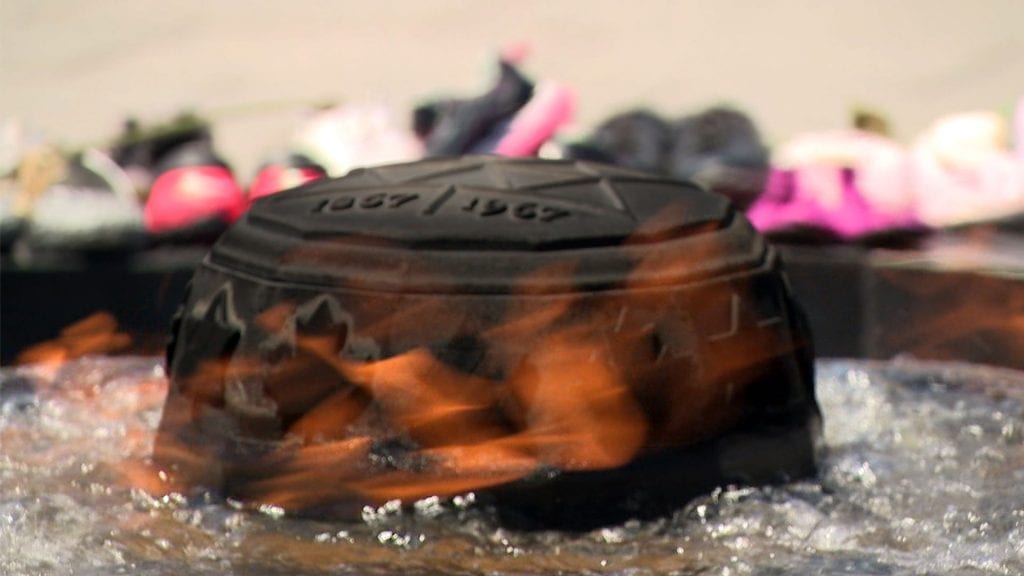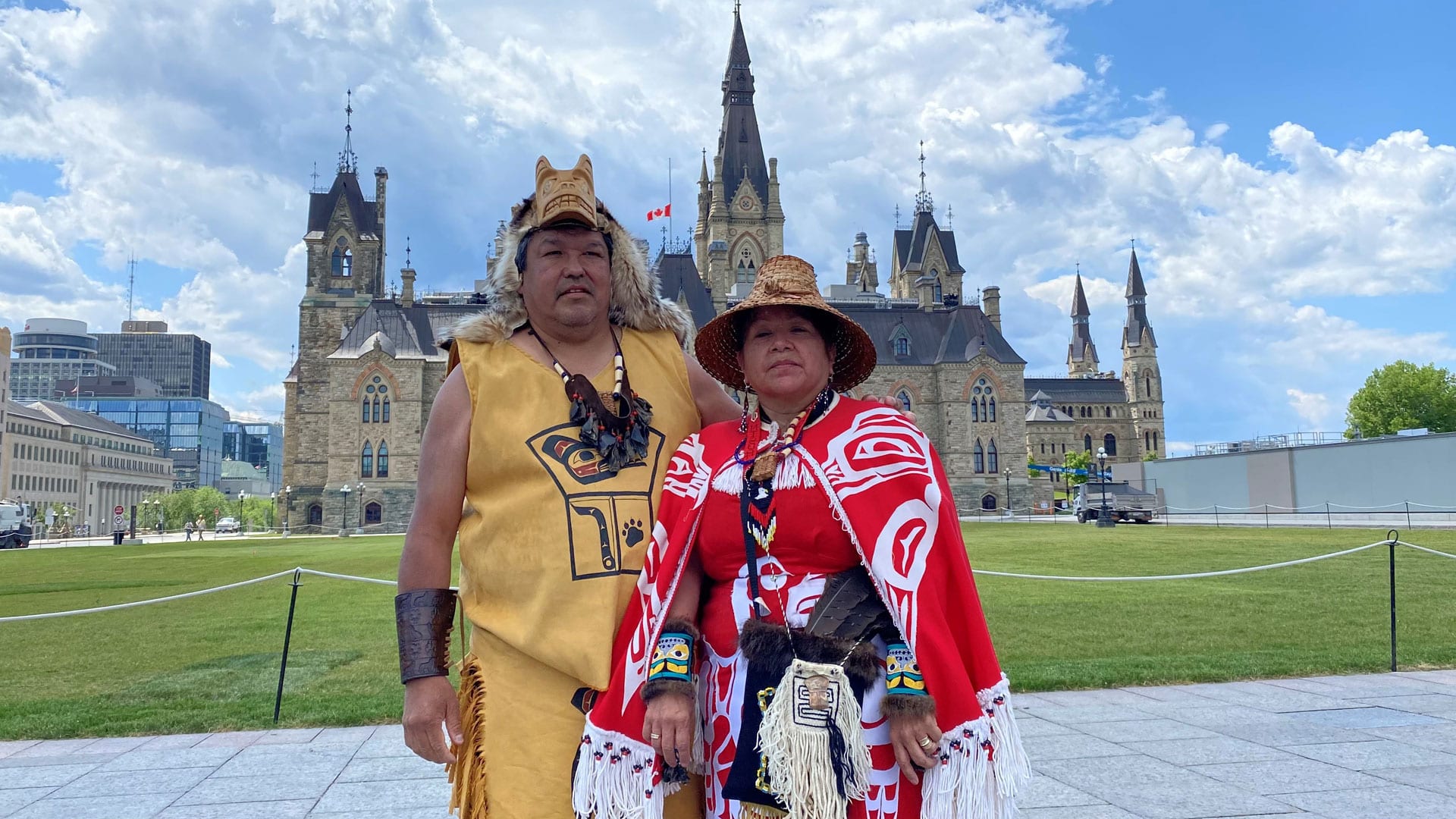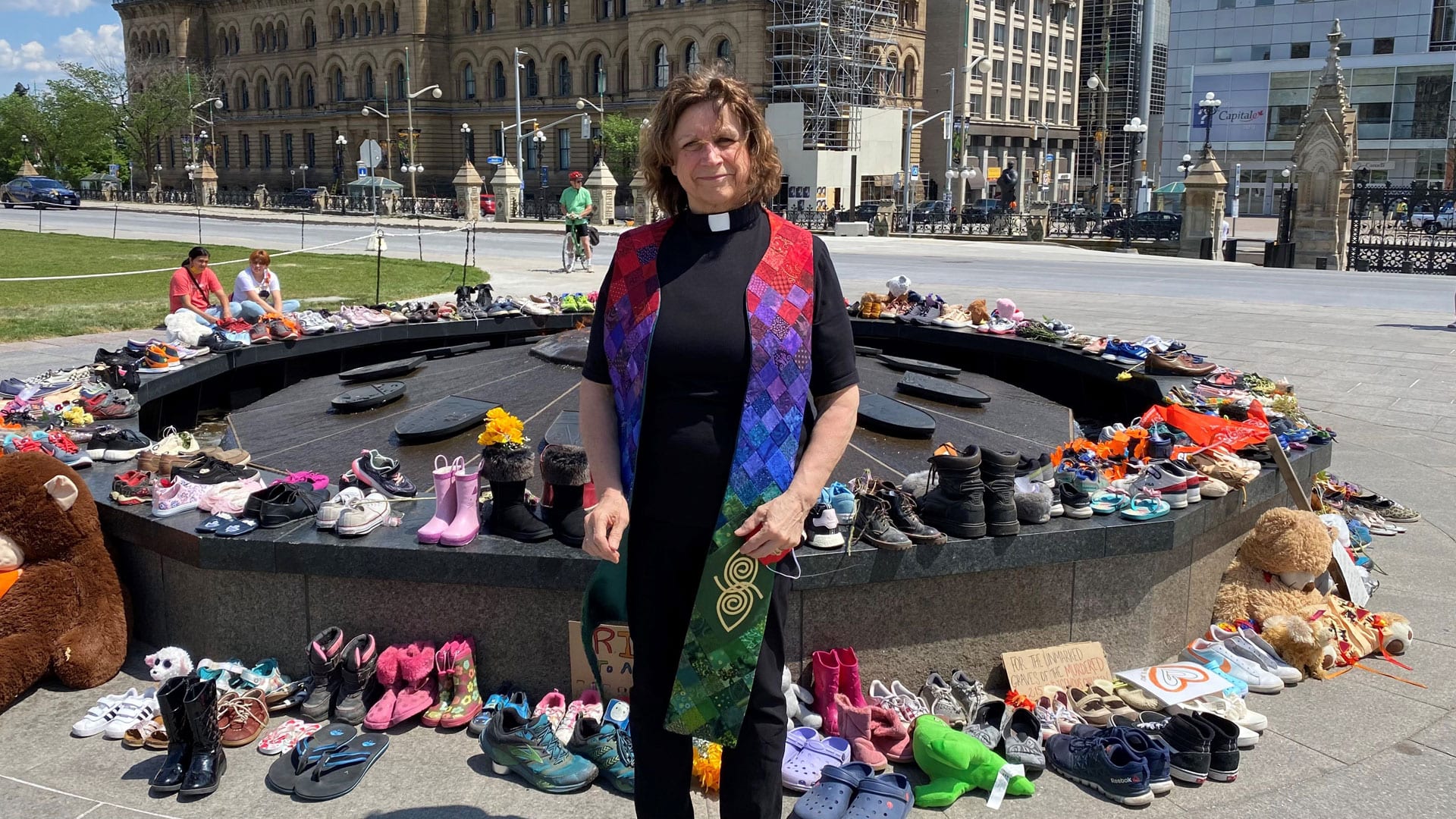
A memorial to children is growing daily after existence of a mass grave at a former B.C. residential school was confirmed. Photo: Jason Leroux/APTN
Warning: Some readers may find this story triggering
The atmosphere is somber as people gather around a memorial of children’s of shoes and teddy bears at the Centennial Flame in Ottawa on a warm, quiet Monday evening.
Everyone wears orange, and tears flow for the 215 children found in an unmarked, mass grave outside a former residential school on Tk̓emlúps te Secwépemc territory in Kamloops, B.C.
I lay a small red bundle of tobacco down beside a sprig of cedar. It feels like the medicines ought to be near a sacred fire, not one that reeks of kerosene when the wind blows the wrong way.
But I do it anyway. I ask the children to accept the ceremonial offering, small as it is. On Tuesday, I return and watch as a Nisga’a couple from northwestern B.C. lead a traditional peace ceremony.
A woman in bright red and white regalia blows hard into a shell and the sound echoes across the terrace while her husband beats on the drum and sings.
“We’re dancing for the children,” she shouts. And soon about 50 people join, dancing in a circle around the fire, where the memorial grows larger every day.
“We sing that when we come in, when we first arrive, to acknowledge the territory we’re on,” the woman, whose name is Wii T’isim Hanakum Skaaqkw, tells me afterward.
Normally, she explains, four young women from the tribes are selected to perform the ceremony, which involves laying eagle feathers on the ground and blowing them up into the air.
“They call it washing,” she says, “so, by singing it, we washed around the children today.”
She and her husband Gwee’e came to the site a day earlier and sang directly to the children.

But they come back to sing again to help others mourn, grieve and heal. I ask them why.
“In order for everyone to acknowledge and feel that, they had to partake,” she replies. “Then they could see how we feel. Because when we were singing and dancing, we were dancing for the children. Not for us. We were dancing for those souls. Those souls, they are not lost; they are found. But they are now reunited with our ancestors.”
They prefer not to use their Christian names. Not too long ago, all this was illegal. Singing, dancing, speaking, regalia — simply existing as First Nations — were not permitted by the colonial authorities.
Residential schools were a central part of that project of assimilation, eradication and colonization. The church and the state used violence, intimidation and fear to foster shame and obedience in children. That stigma still exists, explains Gwee’e.
“On the way up here, we parked the car and this older gentleman — we were just walking up, I didn’t have my apron on, just my shirt and my headband — he said, ‘Oh, are you guys protesting?’ I said, ‘No, we’re going to sing songs’,” he recalls. “That’s the stigma. As soon as they see the regalia, they go, ‘Oh, there’s a protest’.”
But it’s not a protest. Many are just too sad to protest. Indigenous people across the country find themselves feeling helpless, traumatized and saddled with sorrow so profound it almost escapes words. Everyone has a story about residential school, and many are coming out.
“Most of our performances are stories,” says Wii T’isim Hanakum Skaaqkw. “We come in peace and we want to provide peace when we come and when we leave.”
For Gwee’e, it’s an uncle’s story. Gwee’e comes to show pride in his language, culture and songs. “For me personally, it soothes the soul,” he says. “I love to sing.”
And it may not be a protest, but it is a small yet powerful act of defiance.
“We were here as the First Nations. We lived. We lived off the land. I shouldn’t need to go away from my home to make money,” he says. “But that’s what it comes down to now. So with us blending in with society and living by the rules, we also are proud to show our heritage of where we came from.”
And for many, the road to healing goes not just through grief, but through ceremony, pride and song.

Rev. Lorrie Lowes joins in. Wearing a white clerical collar and a black shirt, she stands out in the crowd.
She came “to be the face of the church,” she says. “I’m surprised I’m the only one here to be honest. I think we have so much to answer for. There’s a lot of shame, but I think it’s shame that we need to own, not because we caused it personally as individuals, but because we benefit.”
She’s a diaconal minister at a United Church in a small suburb in west Ottawa. The Nisga’a couple are parishioners.
Politicians arrive at the memorial while we speak. They stand amid the regular people and bow their heads in silence. Another song starts up. I point them out to her. She smiles.
“I hope they are really standing with the people,” she says, “and not looking for a photo op.”
The House of Commons sits in West Block only a few metres away. Many are calling on politicians to act. They shed tears of their own late into a Tuesday evening debate.
Calls are also growing for the Vatican to apologize and turn over residential school records.
“I never heard anything from the Catholic church, the pope, even acknowledging what they had done,” says Gwee’e. “And that’s something that’s still in my head.”
But it wasn’t just the Vatican. Other Christian denominations had a hand in operating the residential school system. Not all have made amends. The reverend agrees it’s time to act.
“Apologies are important, but action is more important,” says Lowes. “It’s terrible that we’re still taking children out of their families, taking children away from their culture. There are no residential schools, but there still is a foster system that is stacked against these folks. So that needs to happen. Clean water needs to happen. It’s ridiculous.”
Read More:
‘It was horrid’: Survivor tells APTN News about loss and fear at Kamloops residential school
Remains of 215 children found at former residential school in British Columbia
(APTN News reached out numerous times to Msgr. Matjaz Roter from the Vatican’s embassy in Ottawa with questions about Kamloops and an apology. “I can’t answer your questions,” an official said when reached by phone Wednesday.)
As the songs finish and the crowd departs, one young woman remains. She offers her contact information to those present, asking them to return the next day.
Her name is Jacqueline Shigwadja, she says, and she’s from Wiikwemkoong Unceded Territory on Manitoulin Island.
She says she organized the singing and sharing circle after she too visited the memorial on Monday. She watched as Indigenous people came seeking ceremony and went away dejected when they didn’t find it.
“A lot of them became very sad and distressed,” she says. “We initiated a circle with everybody around. And I really got to see how it healed and helped soothe the pain of the ones who came seeking help and support.”
She’s not part of any organization or group, just an individual grappling with sadness and a sense of helplessness.
“I’ve been crying like every day since I found out, and I’ve been feeling extremely helpless. I want to do something,” she explains. “I want to hold these children and just tell them that they’re loved. I just want to hug them and not let them go. But I can’t do that. This is all I could do. Being here is the only thing that I could do. So I’m here.”
Coming together in ceremony is how people gain strength from their ancestors, she says.
“The community helps me. It’s like I’m not alone,” she says. “I know I’m not the only one feeling what I’m feeling. Because we all feel and mourn the children that were found and the ones that are still missing.”
Shigwadja does what’s within her power. Those inside West Block have power to do a lot more. She says she’d like to see them do one thing.
Bring the children home.
“I want them to have proper burial sites. I don’t want them to be another body under the ground somewhere. We deserve to know where they are. They deserve to have their names heard and their stories heard,” she says. “I’m coming out as long as these shoes are here. Everyday.”
She’s not alone in that call.
But for now, it’s time to mourn.
“We are grieving,” says Wii T’isim Hanakum Skaaqkw.
“Give us time to grieve.”
The National Indian Residential School Crisis Line is available to provide emotional and crisis referral services to former residential school students. It is available 24 hours a day at 1-866-925-4419. All Indigenous Peoples can access the Hope for Wellness Help Line at www.hopeforwellness.ca or by phoning 1-855-242-3310









